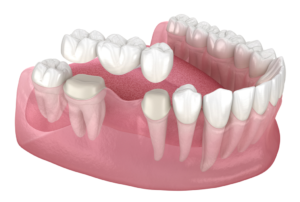
Dental bridges are a great choice for patients who have missing teeth or experienced bone loss after dental surgery. They’re also an excellent option for patients who wish to retain their natural appearance and teeth function. Dental bridges, in a literal sense, bridges the space left by one or more missing teeth.
A bridge includes an artificial tooth and two or more dental crowns (teeth-shaped permanent caps placed on weak or damaged teeth) to fill the gaps in-between the teeth. These artificial teeth can be made of porcelain, alloys, gold, or a combination of these materials.
What does it consist of?
A typical dental bridge consists of the following:
Abutment teeth: They are the base of the dental implants or act as the crown for the teeth that serve as support on either side of the gap.
Pontics: These are artificial teeth that bridge the space and are fastened to nearby crowns.
What are its different types?
There are four primary types of bridges.

Traditional fixed bridge: This is the most typical type of bridge. It has one, two, or more connected filler teeth and one or more crowns. Metal, porcelain fused to metal, or ceramics are the materials used to make bridges.

Cantilever bridge: The abutment teeth serve as the pontic’s point of contact in a cantilever bridge. If you only have teeth on one side of the gap, this is an ideal option.

Maryland dental bridge (resin-bonded bridge): If your front teeth are missing, a Maryland dental bridge can be the best option for you. It is made of porcelain bonded to metal or ceramic teeth. Each side of the bridge has thin metal wings attached to your natural teeth.

Implant-supported bridge: This is a fixed bridge supported by implants, contrary to glued to teeth like a traditional fixed bridge.
What are its benefits?
A dental bridge can:
- Fill in the gaps in your mouth.
- Restore the ability to talk and chew properly.
- Preserve the contour of your face.
- Help you put pressure on every tooth equally to bite properly.
- Prevent the remaining teeth from shifting or moving.
- Bring back your complete smile.
How is it placed?
Preparation of the abutment teeth: During your initial visit, your doctor will reshape the abutment teeth. Some of the enamel and dentin will be removed to make way for the crown.
Impressions: Your dentist will take digital scans of your teeth. Your bridge, fake teeth, and crowns are all made in a dental laboratory using a customized mold. While the lab prepares your bridge, you will have a temporary bridge to cover the exposed parts in your mouth.
Permanent bridge placement: During your second visit, your doctor will replace the temporary bridge with the new one. If needed, modifications can be made to it.
How long does it last?
Dental bridges can last for 5-7 years, at the very least. However, the bridge could endure more than 10 years with appropriate oral care and regular expert cleanings.
Missing teeth can limit your ability to eat, speak, and smile. A dental bridge can make your mouth look and feel better. Consult our experts at Bravo! Dental to determine whether a dental bridge is the best option for you.
happy to hear from you, contact us
Fill out the contact form below and Feel free to send any question or query.




